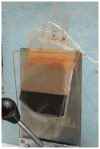Gravity sedimentation of granulocytapheresis concentrates with hydroxyethyl starch efficiently removes red blood cells and retains neutrophils
- PMID: 20113453
- PMCID: PMC3421031
- DOI: 10.1111/j.1537-2995.2009.02576.x
Gravity sedimentation of granulocytapheresis concentrates with hydroxyethyl starch efficiently removes red blood cells and retains neutrophils
Abstract
Background: Transfusion of granulocytapheresis concentrates can be limited by the volume of incompatible donor red blood cells (RBCs) in the component. Efficient reduction of RBCs in granulocyte units would result in safe transfusion of RBC-incompatible units.
Study design and methods: Granulocyte concentrates were collected by continuous-flow apheresis from granulocyte-colony-stimulating factor (G-CSF) and dexamethasone-stimulated volunteer donors, with 6% hydroxyethyl starch (HES) added continuously during apheresis as a RBC sedimenting agent to enhance granulocyte collection efficiency. After collection, the component was placed in a plasma extractor for 4 hours. A sharp line of demarcation between the starch-sedimented RBCs and the granulocyte-rich supernatant developed, and the supernatant was transferred to a sterilely docked transfer pack. RBC reduction and white blood cell recovery were determined.
Results: Gravity sedimentation was performed on 165 granulocyte concentrates. Mean sedimentation time was 267 minutes (range, 150-440 min). RBC depletion was 92% (range, 71%-99%) with mean residual RBC content of 3.2 +/- 1.4 mL. Twelve percent of components contained less than 2 mL of RBCs. Mean granulocyte and platelet (PLT) recoveries were 80 and 81%, respectively. There were no transfusion reactions or signs of hemolysis after transfusion of 66 RBC-incompatible granulocyte concentrates (RBC volume, 1.6-8.2 mL). The remaining concentrates were used for topical or intrapleural applications.
Conclusions: RBCs were significantly reduced and granulocytes and PLTs effectively retained in G-CSF/steroid-mobilized granulocyte components collected with HES and processed by gravity sedimentation. This procedure allows safe transfusion of RBC-incompatible sedimented granulocyte units and may be used to expand the pool of available granulocyte donors for specific recipients.
Conflict of interest statement
The authors have no conflict of interests to disclose.
Figures


References
-
- Hester JP, Dignani MC, Anaissie EJ, Kantarjian HM, O’Brien S, Freireich EJ. Collection and transfusion of granulocyte concentrates from donors primed with granulocyte stimulating factor and response of myelosuppressed patients with established infections. J Clin Apheresis. 1995;10:188–93. - PubMed
-
- Price TH, Bowden RA, Boeckh M, Bux J, Nelson K, Liles WC, Dale DD. Phase I/II trial of neutrophil transfusions from donors stimulated with G-CSF and dexamethasone for treatment of patients with infections in hematopoietic stem cell transplantation. Blood. 2000;96:3302–9. - PubMed
-
- Adkins DR, Goodnough LT, Shenoy S, Brown R, Moellering J, Khoury H, Vij R, DiPersio J. Effect of leukocyte compatibility on neutrophil increment after transfusion of granulocyte colony-stimulating factor-mobilized prophylactic granulocyte transfusions and on clinical outcomes after stem cell transplantation. Blood. 2000;95:3605–12. - PubMed
-
- Lee JJ, Chung IJ, Park MR, Hwang TJ, Ryang DW, Kim HJ. Clinical efficacy of granulocyte transfusion therapy in patients with neutropenia-related infections. Leuk. 2001;15:203–7. - PubMed
-
- Illerhaus G, Wirth K, Dwenger A, Waller CF, Garbe A, Brass V, Lang H, Lange W. Treatment and prophylaxis of severe infections in neutropenic patients by granulocyte transfusions. Ann Hematol. 2002;81:273–81. - PubMed
MeSH terms
Substances
Grants and funding
LinkOut - more resources
Full Text Sources
Medical

